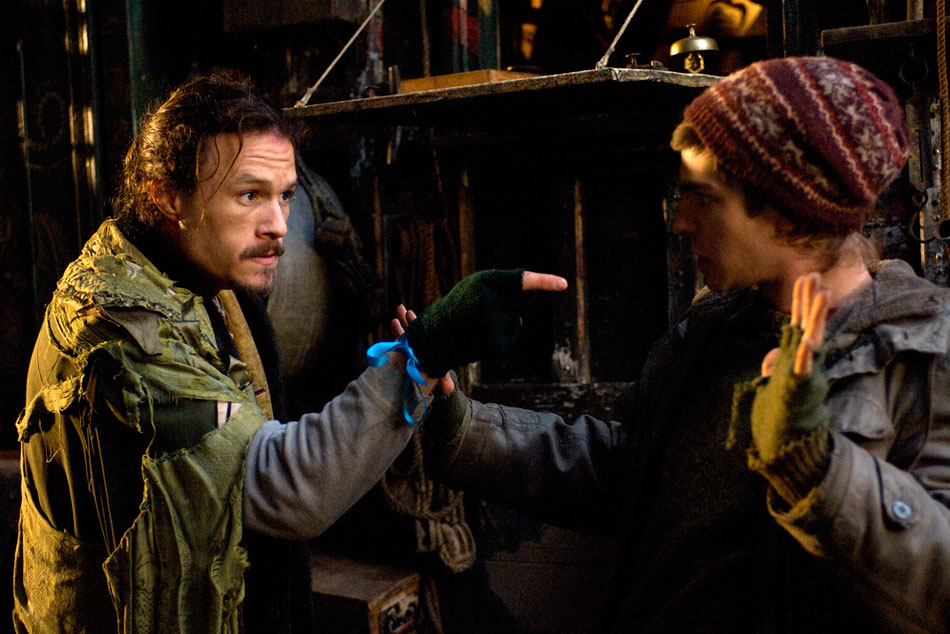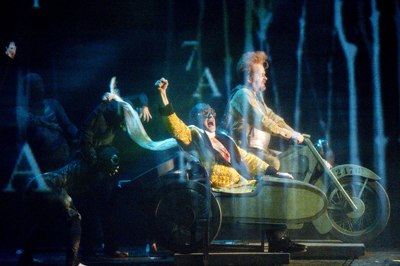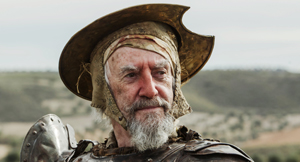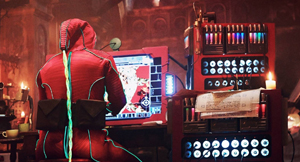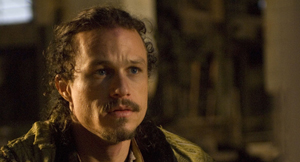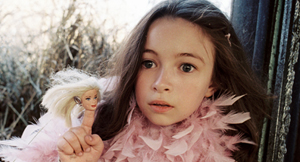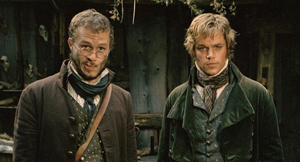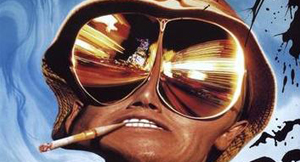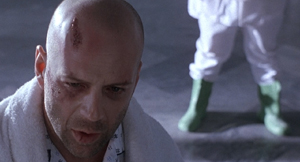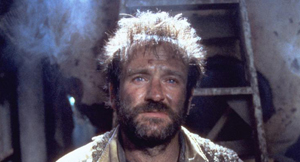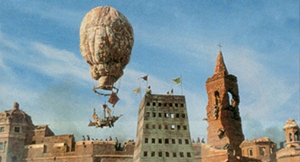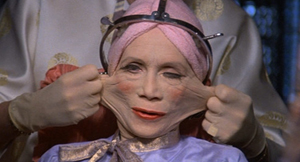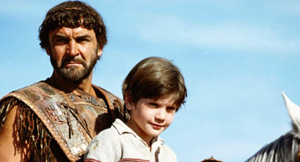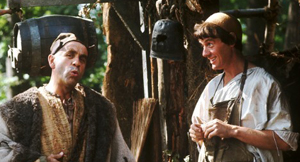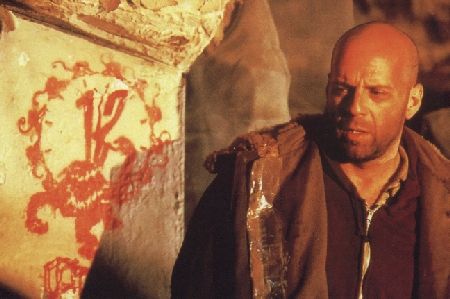
Bruce Willis as James Cole in 12 Monkeys
Introduction to Twelve Monkeys from the Programme Notes
“The human race was doomed. It was cut off from space.
Its only hope for survival was time…emissaries in time
to summon the past and the future to the aid of the present.
One man was chosen for his obsession with an image from the past,
but he is never sure whether he invents or dreams.”
… from La Jetee (1962)
Screenwriters David and Janet Peoples drew their inspiration for 12 MONKEYS from French filmmaker Chris Marker’s haunting and provocative 1962 short film, La Jetee (The Runaway).
Roven had collaborated with the respected screenwriter Peoples (Unforgiven, Blade Runner) once before, on the 1990 futuristic adventure, The Blood of Heroes, which Roven produced and Peoples wrote and directed. Roven comments, “What they came up with was something inspired by La Jetee, but is uniquely 12 MONKEYS. They did a spectacular job”. He goes on to say, “The Peoples wrote a script that, because of its time-travel aspect and its different worlds aspect, needed somebody who could give it a fantastic visual sense. And, the perfect director for it was Terry Gilliam”.
Gilliam’s own time travels behind the camera have produced some of the most dazzling and imaginative visuals ever portrayed on the movie screen, from the magical fantasy Time Bandits to the visually-stunning Orwellian world in Brazil to the quest for mankind’s redemption in contemporary New York in The Fisher King.
12 MONKEYS represents only the second film for which Gilliam did not write his own screenplay. Although he prefers working in that capacity, he was captivated, he admits, by the Peoples’ “intriguing and intelligent script. The story is disconcerting. It deals with time, madness and a perception of what the world is or isn’t. It is a study of madness and dreams, of death and re-birth, set in a world coming apart”, visions that the filmmaker vividly explored in such earlier works as Brazil and The Fisher King.
Gilliam, who first met Bruce Willis while casting The Fisher King found it intriguing “when Bruce’s name came up for this because the story needed somebody who is strong and dangerous but also vulnerable. And, I remember a scene in the first Die Hard where he’s picking glass out of his feet while on the phone to his wife. He starts crying as he’s talking and I thought it was such a wonderful scene where a guy could be that sensitive and macho at the same time. It’s paid off wonderfully. People are going to be astounded by his performance”, Gilliam proclaims.
Willis himself was also captivated by the “really good script and my desire to work with Terry, one of our most gifted storytellers. Terry chooses good scripts and is always involved with something very, very intriguing”.
“I was intrigued by the notion of exploring what psychosis is”, the actor goes on to say. “During the film, other people think I’m crazy. For some of the film, I think I’m crazy myself. For most of the film, we dangle the question for the audience – is the man truly psychotic, or are these events he foretells actually happening? You never know until the very end of the film, and it’s a nice surprise”, he concludes.
And, his stark look was further enhanced by his makeup artist, Cristina Bartolucci, who, everyday, etched a trio of tattoos onto Willis’ scalp and neck – one that indicated his prisoner number, and a pair of bar-codes, the kind imprinted on packaged goods, on each side of his neck.
Gilliam chose Madeleine Stowe to play the psychiatrist and author, Dr. Kathryn Railly, who is kidnapped by the time-traveller and thrust into his absurd adventure to save the planet. The award-winning actress perceived her character as “not the most balanced human being in the world, and not necessarily good at what she does. She’s not as gifted and not as intelligent as she thinks”.
Ironically, it was Stowe’s “incredible intelligence”, says Gilliam, that won her the role the filmmaker calls “the key, the anchor of the piece” and one co-star Willis defines as “the hardest part in the film”. Willis emphasizes her challenge by saying “I get to slobber and rant and rave, but Madeleine has a difficult part. She has to play this straight-thinking doctor, very rational, who guides the audience through the madness”.
Stowe, who won accolades for her work in Blink and The Last of the Mohicans and captured the National Society of Film Critics prize for Robert Altman’s Short Cuts, had initially met Gilliam a few years ago to discuss another project. It was her commanding performance in Michael Apted’s thriller Blink that caught Gilliam’s eye.
“She’s just one of the finest actresses out there,” the director proclaims. “She has this incredible ethereal beauty and she’s incredibly intelligent. Those two things rest very easily with her, and the film needed those elements because it has to be romantic.”
Stowe was also delighted to be working with Gilliam. “You have few opportunities in life to work with someone like Terry”, enthuses the actress. “I loved the script, and really wanted to work with him badly. There aren’t many directors who are as stunning as he is in their approach. He’s provocative, much like Robert Altman, in the sense that they both love chaos. Terry doesn’t like to follow the expected course of things. This has been the most disorienting experience I’ve ever had”.
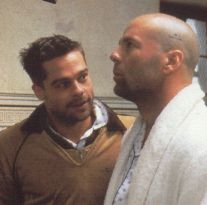
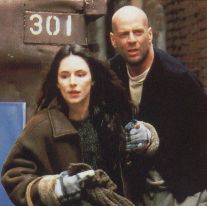
Brad Pitt took on the role of Jeffrey Goines, the leader of a band of animal activists whose father (played by Christopher Plummer) has created a test-tube virus that may have been unleashed into the population by Pitt and his cohorts as a deadly protest against the researcher’s abuse of laboratory animals.
“Brad was keen to do the part, one that was so unlike anything he’d tried before”, Gilliam comments. “He plays a fast-talking, wild, crazed person. I was intrigued by the idea, always like the idea, of casting against type. Brad has taken a leap, a dangerous leap, that’s going to amaze people”.
In Philadelphia, months before joining the production, Pitt spent weeks at Temple University’s hospital, visiting the psychiatric ward to prepare for his role as Jeffrey, the disturbed radical. To nail his research, Pitt did not visit Temple just to observe, he went in character.
Like Bruce Willis, Pitt also registered a drastically different look for the role. “Brad saw his character as a Charles Manson type, and developed the look of Jeffrey based on some of the people he met at Temple”, Gilliam notes. “He shaved parts of his head and developed a hypnotic intense look”.
“For the role of Jeffrey, we needed somebody magnetic”, producer Roven declares. “Someone you were compelled to look at. The role is something very different for Brad, the kind of character we hoped he’d be interested in playing. It adds another dimension to his career.”
For the role of the Nobel-winning scientist, Dr. Leland Goines, Gilliam tapped the multi-dimensional talents of Tony-and-Emmy Award-winning actor Christopher Plummer.
Plummer, who was coerced into the pivotal guest-star part by Gilliam’s “diabolical charm”, calls the story “a riveting adventure, diabolically complicated. My part is rather decadent, devious, oily, not an evil son-of-a-bitch, but a sort of unaware freak. It’s the sort of part that’s nice to play. One where they talk about you for the first two acts, then you come on in the third.”
“Here we take this great actor who’s been in so many amazing films, done some of the finest work ever on-stage, and we end up putting him in a body bag”, Gilliam muses about one of the world’s most accomplished performers, whose prominence in the American theatre is unparalleled. “And, he’s got to act his way out of a sack. A Shakespearean actor acting in a sack. It reminded me of Robert De Niro acting with a bag over his head in Brazil.”
“I’m not drawn to straightforward stories”, Gilliam admits, “but to more complex ones. This film is a tragedy in a strange way, but also a love story and it deals with death and resurrection. It’s a hard film to describe, it doesn’t fit neatly into a bag. It’s not high concept. It’s not your typical Hollywood film, and will demand something of the audience.”


